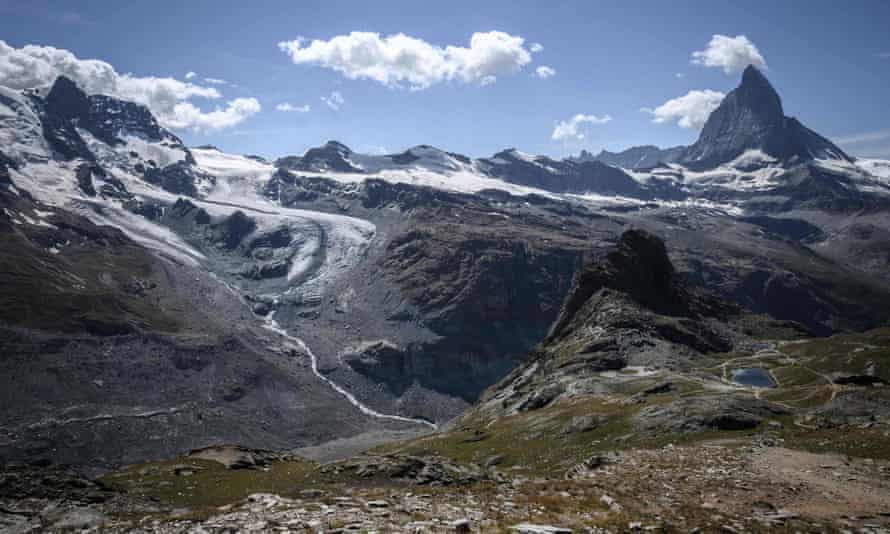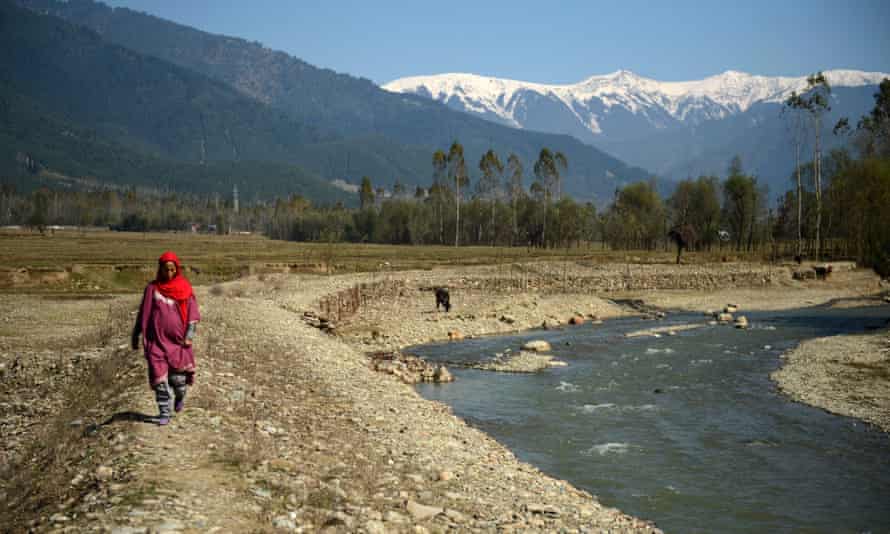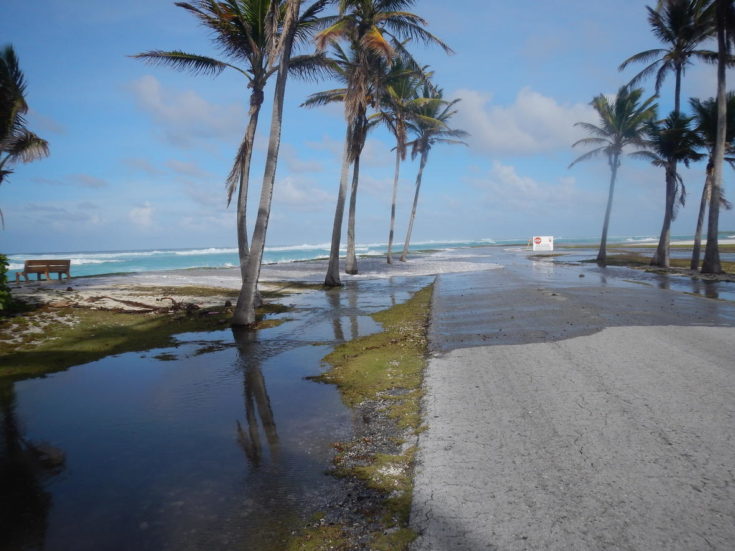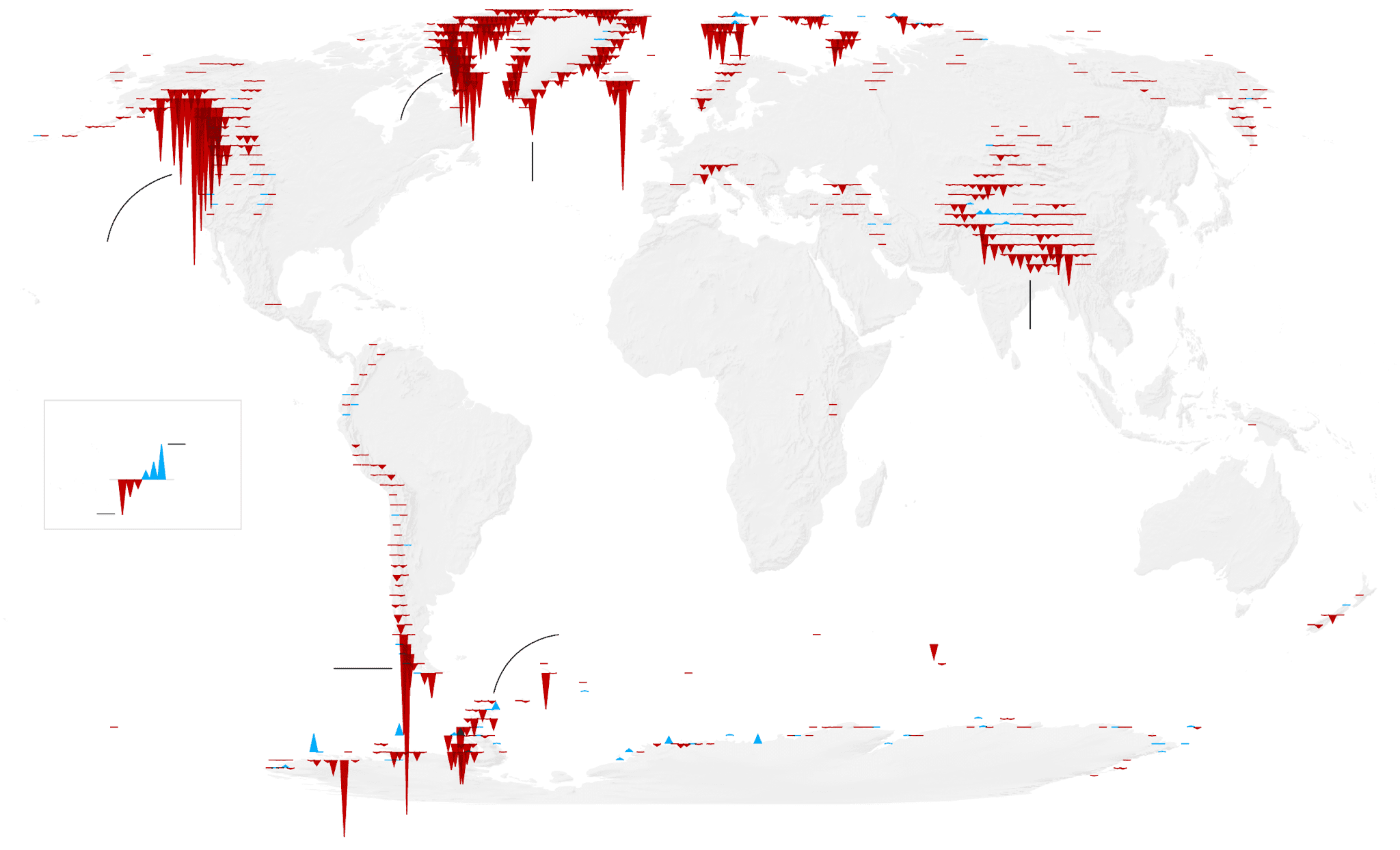Unearthed (Greenpeace) wijst in haar nieuwsbrief naar The Guardian waarin een wetenschappelijk artikel is te vinden over het ‘afsmelten’ van gletsjers de laatste 20 jaar, daaruit blijkt dat er in die periode jaarlijks de belachelijke grote hoeveelheid van 267 gigaton ijs is verdwenen, een hoeveelheid water waarmee je de gehele oppervlakte van Groot-Brittannië tot 2 meter onder water kan zetten en dat jaar na jaar….
Uiteraard blijft dit niet zonder gevolgen, zo wordt op de vrijgekomen plek zonnewarmte opgenomen i.p.v. weerkaatst, waardoor de klimaatverandering verder wordt opgejaagd en die zorgt dat er nog meer ijs wegsmelt en plek vrijkomt waar de zon de aarde verwarmt, enz. enz….. De kleine eilanden in de Stille en Indische Oceaan hebben al flink last van de zeespiegelstijging* en de tijd is niet meer ver weg dat de bewoners geëvacueerd zullen moeten worden, daar hun geboortegrond niet meer leefbaar is…..
Door de opwarming verdwijnt overigens ook een deel van de ijskappen aan de Noord- en Zuidpool, waardoor daar vrijgekomen zeewater, of rotsen/grond (op Antarctica) meer warmte opnemen, met als gevolg dat er nog meer ijs wegsmelt enz. enz. Voorts ontdooit door de opwarming de permafrost** waarbij enorme hoeveelheden methaangas vrijkomen (een 80 keer zo sterk broeikasgas dan CO2) die de aarde verder opwarmen, daardoor ontdooit er nog meer permafrost enz. enz. (als de voorgaande ook een zogenaamd cumulatief effect) Wetenschappers denken voorts dat er door het smelten van de permafrost ook besmettelijke ziekten zullen vrijkomen, die de mens nog niet kent en tot een pandemie kunnen leiden….***
Hier een video van Google Earth met beelden van de aarde die de laatste 37 jaar omspannen, op 1:19 min. zie je een deel van Groenland en wat er over is van ijs in dat gebied:
Hier de link naar het ‘timelaps’ programma op Google Earth, al werkt het allemaal bepaald niet perfect, wel kan je bijvoorbeeld zoeken naar gletsjers (glaciers), Antarctica of de Noordpool en zien wat er nog over is aan ijs vergeleken bij 1984, bepaald niet iets om vrolijk van te worden, al geldt dat ook voor het bericht op The Guardian…… Als we echt willen dat er werkelijk watten goede verandert zal er naar ik vrees een (gewelddadige) revolutie nodig zijn, wachten op politiek en bedrijven is letterlijk en figuurlijk de dood in de pot!!
Speed at which world’s glaciers are melting has doubled in 20 years
Glacier melt contributing more to sea-level rise than loss of Greenland and Antarctic ice sheets, say experts
Jonathan Watts and Niko Kommenda
Portage glacier in Chugach National Forest in Alaska. The US state accounted for 25% of global glacier loss Photograph: Yereth Rosen/Reuters
The melting of the world’s glaciers has nearly
doubled in speed over the past 20 years and contributes more to
sea-level rise than either the Greenland or Antarctic ice sheets,
according to the most comprehensive global study of ice rivers ever
undertaken.
Scientists say human-driven global
heating is behind the accelerating loss of high-altitude and
high-latitude glaciers, which will affect coastal regions across the
planet and create boom-and-bust flows of meltwater for the hundreds of
millions of people who live downstream of these “natural water towers”.
Between 2000 and 2019, glaciers lost 267 gigatonnes (Gt) of ice per year, equivalent to 21% of sea-level rise, reveals a paper published in Nature. The authors said the mass loss was equivalent to submerging the surface of England under 2 metres of water every year.
This
was 47% higher than the contribution of the melting ice sheet in
Greenland and more than twice that from the ice sheet in Antarctica. As a
cause of sea-level rise, glacier loss was second only to thermal
expansion, which is prompted by higher ocean temperatures.
(Voor een meer duidelijk beeld, waarin ook het aantal tonnen verdwenen ijs in cijfers wordt getoond zie het origineel op The Gaurdian)
The authors found the pace of glacier thinning
outside of Greenland and Antarctica picking up from about a third of a
metre per year in 2000 to two-thirds in 2019. This is equivalent to an
acceleration of 62Gt per year each decade.
The
study uses historical Nasa satellite data and new statistical methods
to construct three-dimensional topographies going back 20 years and
covering 99.9% of the world’s glaciers. The result is the most accurate
and comprehensive assessment of the world’s 217,175 glaciers to date.
Scientists
said the precision of the data allowed them to be more certain than
before that glacier loss is enormous and accelerating. Previous
estimates of mass loss were about 20% more negative, but those had an
even greater margin of error because they were either extrapolated from
ground measurements at a few hundred reference glaciers and a limited
coverage of satellite imagery, or based on the study of gravimetric
signals which have a coarse resolution.
On
average, the paper found glaciers lost 4% of their volume over 20 years.
But the picture varied across time and from region to region.
Alaska
accounted for 25% of the global mass loss, the Greenland periphery 12%
and north and south Canada 10% each. The Himalayas and other parts of
high-mountain Asia lost 8%, as did the southern Andes and subantarctic
regions.
 The Lower Theodul glacier, near the Matterhorn mountain in Switzerland. Photograph: Fabrice Coffrini/AFP/Getty Images
The Lower Theodul glacier, near the Matterhorn mountain in Switzerland. Photograph: Fabrice Coffrini/AFP/Getty Images
Smaller,
lower glaciers did not contribute as much in volume, but they were the
most vulnerable to change. The thinning of New Zealand’s glaciers
increased seven-fold between 2000-04 and 2015-19. Thinning rates in the
European Alps were twice the global average.
The
lead author, Romain Hugonnet, of the University of Toulouse, said the
data was an urgent warning. “A doubling of the thinning rates in 20
years for glaciers outside Greenland and Antarctica tells us we need to
change the way we live. We need to act now,” he said. “It can be
difficult to get the public to understand why glaciers are important
because they seem so remote, but they affect many things in the global
water cycle including regional hydrology, and by changing too rapidly,
can lead to the alteration or collapse of downstream ecosystems.”
Living
in Switzerland, he feared future generations would not be able to enjoy
the Alps as he has done. “It’s beautiful now but it will get more and
more dry. If there are no glaciers, there will be less water in times of
drought at the end of summer. For the first time, you might not see
green grass in Switzerland,” he said. “ The glaciers in the Alps are not
thick and are [some of the] fastest melting in the world. That will
continue until there is nothing left. How fast depends on different
climate scenarios, but at current speed, 80-90% will be gone by 2050.
That means we will lose almost everything, except the biggest glaciers.”
His
greatest concern was in high Asian mountain ranges, which are the
source of rivers such as the Yangtze, Mekong, Salween and Brahmaputra,
which support large downstream populations. The paper urges policymakers
to design adaptive policies for the billion people who could face water
shortages and food insecurity before 2050, as well as for the more than
200 million who live in coastal areas threatened by rising water levels
before the end of the century.
 A
A
Kashmiri villager walks past what used to be a pond holding drinking
water in the village of Chandigam in the Lolab valley in the foothills
of the northern Kashmir Himalayas, where glaciers are melting fast. Photograph: Tauseef Mustafa/AFP/Getty Images
“India
and China are depleting underground sources and relying on river water,
which substantially originates from glaciers during times of drought.
This will be fine for a few decades because glaciers will keep melting
and provide more river runoff, which acts as a buffer to protect
populations from water stress. But after these decades, the situation
could go downhill. If we do not plan ahead, there could be a crisis for
water and food, affecting the most vulnerable.”
Samuel
Nussbaumer, of the World Glacier Monitoring Service (WGMS) and the
University of Zurich, was not directly involved in the latest assessment
but he said it confirmed trends observed over many decades by ground
monitoring and satellites. The WGMS previously reported that rates of
glacier mass loss have roughly doubled every decade since the 1970s.
“The
new paper will have a big impact. This is the most global, complete
study. The gain in new information is huge,” he said. “The rapid change
we see now is really interesting from a scientific point of view. Never
before in history has change happened this fast.“But on a personal level, it is sad to see. Glaciers
are very dynamic. If temperatures were to drop, they would regrow. But
what is happening today is that human causes are leading to long-term
destruction even in these remote regions where there are no humans.”
==================================================
* Zie: ‘Uitstoot methaangas op hoogste punt sinds men begon met metingen in 1983‘ en zie:
‘Groenlandse ijsmassa smelt weg >> zeespiegelstijging tot 7 meter verwacht……‘ (!!!!)
(de video in dat bericht is ‘weggecensureerd’, ‘logisch’ de mensheid
mag alleen bang gemaakt worden met het Coronavirus en niet voor het veel
grotere gevaar voor de mensheid: de klimaatverandering…… )
** Zie o.a.: ‘De permafrost ontdooit op grote schaal aldus nieuw onderzoek: een enorme aanjager van de klimaatverandering‘ (en zie de links in dat bericht)
*** Zie: ‘Opwarming van Arctisch gebied laat besmettelijke ziekten vrijkomen uit de permafrost‘
————————————
Zie ook: ‘‘Koninklijke Shell’: ondanks ‘groene beloften’ blijft CO2 uitstoot van dit bedrijf stijgen‘
‘Halve graad opwarming van de aarde zal 150 miljoen mensen het leven kosten……‘ (vergelijk dat eens met de oversterfte door het Coronavirus of een andere heftige griepgolf…….)
‘Shell houdt zich niet aan het klimaatakkoord: 8 bewijzen‘
‘NRC, stop met de propaganda van Shell‘ (een artikel van Verbied Fossiele Reclame)
‘ABP investeert door leden gespaard pensioen in de fossiele brandstof vernietiging van onze aarde….‘ (en zie de links in dat bericht, o.a. over de pensioenen)
‘Shell scherpt klimaatdoelen aan, ofwel greenwashing op ‘topniveau’‘
‘Shell en BP op het valsgroene pad met ontkenners van de klimaatverandering‘ (ja ja, men blijft ontkennen, hoewel Shell uit eigen onderzoek weet dat de verbranding
van fossiele brandstoffen de snelle klimaatverandering heeft veroorzaakt
en verder aanjaagt….)
‘Shell positief over LNG markt: hoe is het mogelijk? ha! ha! ha! ha! ha! ha! ha!‘
‘Shell en Exxon lobbyen voor het behoud van eenmalige plasticverpakkingen‘
‘Sluipmoordenaar: verbranding van fossiele brandstoffen hebben in 2018 wereldwijd de dood veroorzaakt van 8.7 miljoen mensen‘ (!!!!) (en zie de links in dat bericht!)
‘Houtstook professioneel en voor huishoudens moet worden verboden‘
‘Australië: steenkoollobby werkt samen met de regering nog veel meer bosbranden in de hand‘
‘CDA wenst geen EU ‘green deal’ en ‘klimaatambassadeur’ de Boer weet niet waar hij over spreekt‘
‘Siemens heeft lak aan de klimaatverandering en haar slachtoffers‘
‘Australië slaat alarm over koraalriffen…….. AUW!!!‘ en zie wat het Groot Barrièrerif betreft ook:
‘De bosbranden in Australië zullen hun weerslag op de hele wereld hebben‘
‘10.000 dromedarissen worden in Australië afgeschoten vanwege droogte‘
‘Australische bosbranden: 500 miljoen dieren dood en een rookpluim die groter is dan Europa’
‘Exxon ‘topman’ vindt klimaatdoelen najagen een onzinnige bezigheid‘
‘Klimaatakkoord en kilometerheffing: één-tweetje ANWB en Rutte 3‘ (en zie de links in dat bericht!)
——————————————-
Zie wat betreft Koninklijke Shell dat zich op een gore manier groen probeert te wassen ook: ‘Shell: een strijd van 13 jaar voordat dit ‘koninklijke bedrijf’ werd veroordeeld voor de enorme olievervuiling in de Nigerdelta‘ en zie wat dit betreft ook: ‘Negen Nigeriaanse milieuactivisten 25 jaar geleden opgehangen na een schertsproces met hulp van Shell‘




